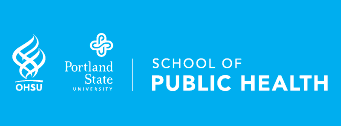Presenter Biography
Vincenzo is a part-time student in his last year enrolled at the OHSU-PSU School of Public Health, working towards his MPH in Epidemiology. He is also currently working as a Graduate Administrative Assistant with the Antiracism & Social Justice team at the School of Public Health.
Corey Linver is a second-year full-time student in the MPH-Epidemiology program at OHSU-PSU School of Public Health, who recently concluded an internship with Multnomah County Environmental Health Department. Her work includes qualitative research on the interactions between accessability to information about environmental hazards and health outcomes among diverse communities.
Program/Major
MPH in Epidemiology
Student Level
Masters
Presentation Type
Poster
Start Date
4-10-2025 1:30 PM
End Date
4-10-2025 2:45 PM
Creative Commons License or Rights Statement

This work is licensed under a Creative Commons Attribution 4.0 License.
Persistent Identifier
https://archives.pdx.edu/ds/psu/43474
Subjects
Epidemiology
Abstract
Objective: This analytic study examined the joint and independent associations between language preferences and healthcare access on moderate to severe depression among non-institutionalized adults living in the U.S., using data from the 2015 to March 2020 National Health and Nutrition Examination Survey (NHANES).
Methods: In this cross-sectional study design, we analyzed a nationally representative data set comprised of 11,051 participants. Multivariable logistic regression models were used to estimate the joint and independent associations between our dual exposures and moderate to severe depression, adjusting for key demographic variables based on our theoretical framework. We created categorical measures of preferred language (speaking a non-dominant or dominant language in the U.S.) and healthcare access (uninsured, inadequately insured, and adequately insured) based on previous research and theories of healthcare access. Depression severity was assessed using the validated Patient Health Questionnaire (PHQ-9). All measures were based on self-report.
Results: The prevalence of moderate to severe depression in the analytic sample was 8.2% (95% CI: 7.5%, 8.9%). Participants who spoke a non-dominant language and were adequately insured had a lower estimated prevalence of experiencing moderate to severe depression compared to the reference group (speaking a dominant language and adequately insured), with an observed adjusted OR of 0.89 (95% CI: 0.52, 1.52). In contrast, the prevalence odds of moderate-severe depression among those who spoke a dominant language and were inadequately insured was 1.56 times (95% CI: 1.11, 2.18) higher compared to the reference group. Compared to the referent group, participants with both co-exposures present (inadequate insurance and speaking a non-dominant language) had 0.66 (95% CI: 0.34, 1.30) times lower adjusted odds of reporting moderate to severe depression. Individuals who spoke a non-dominant language and were uninsured also reported a lower adjusted odds ratio of 0.51 (95% CI: 0.28, 0.93) of experiencing moderate to severe depression compared to those who spoke a dominant language and were uninsured, who reported an adjusted odds ratio of 1.17 (95% CI: 0.90, 1.52). The interactions between language and healthcare access with depression in the adjusted model and were significant below the p
Conclusion: Findings suggest that speaking a non-dominant language when adequately insured could be a protective factor for depression, independent of potential confounders. We also found evidence of an interaction between the healthcare access measure based on insurance status and speaking a non-dominant language. Our findings underscore the need for future research that extricates the effect of language use and healthcare access on depression by considering longitudinal designs, more comprehensive access measures, and mixed methods with a qualitative component that captures the lived experiences of multilingual participants.
The Intersecting Association of Speaking a Non-Dominant Language and Lower Healthcare Access on Self-Reported Depression Among U.S. Adults: A Cross Sectional Study using NHANES Data (2015-March 2020)
Objective: This analytic study examined the joint and independent associations between language preferences and healthcare access on moderate to severe depression among non-institutionalized adults living in the U.S., using data from the 2015 to March 2020 National Health and Nutrition Examination Survey (NHANES).
Methods: In this cross-sectional study design, we analyzed a nationally representative data set comprised of 11,051 participants. Multivariable logistic regression models were used to estimate the joint and independent associations between our dual exposures and moderate to severe depression, adjusting for key demographic variables based on our theoretical framework. We created categorical measures of preferred language (speaking a non-dominant or dominant language in the U.S.) and healthcare access (uninsured, inadequately insured, and adequately insured) based on previous research and theories of healthcare access. Depression severity was assessed using the validated Patient Health Questionnaire (PHQ-9). All measures were based on self-report.
Results: The prevalence of moderate to severe depression in the analytic sample was 8.2% (95% CI: 7.5%, 8.9%). Participants who spoke a non-dominant language and were adequately insured had a lower estimated prevalence of experiencing moderate to severe depression compared to the reference group (speaking a dominant language and adequately insured), with an observed adjusted OR of 0.89 (95% CI: 0.52, 1.52). In contrast, the prevalence odds of moderate-severe depression among those who spoke a dominant language and were inadequately insured was 1.56 times (95% CI: 1.11, 2.18) higher compared to the reference group. Compared to the referent group, participants with both co-exposures present (inadequate insurance and speaking a non-dominant language) had 0.66 (95% CI: 0.34, 1.30) times lower adjusted odds of reporting moderate to severe depression. Individuals who spoke a non-dominant language and were uninsured also reported a lower adjusted odds ratio of 0.51 (95% CI: 0.28, 0.93) of experiencing moderate to severe depression compared to those who spoke a dominant language and were uninsured, who reported an adjusted odds ratio of 1.17 (95% CI: 0.90, 1.52). The interactions between language and healthcare access with depression in the adjusted model and were significant below the p
Conclusion: Findings suggest that speaking a non-dominant language when adequately insured could be a protective factor for depression, independent of potential confounders. We also found evidence of an interaction between the healthcare access measure based on insurance status and speaking a non-dominant language. Our findings underscore the need for future research that extricates the effect of language use and healthcare access on depression by considering longitudinal designs, more comprehensive access measures, and mixed methods with a qualitative component that captures the lived experiences of multilingual participants.


